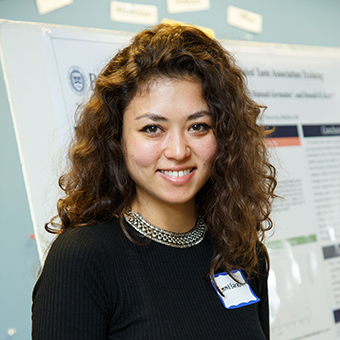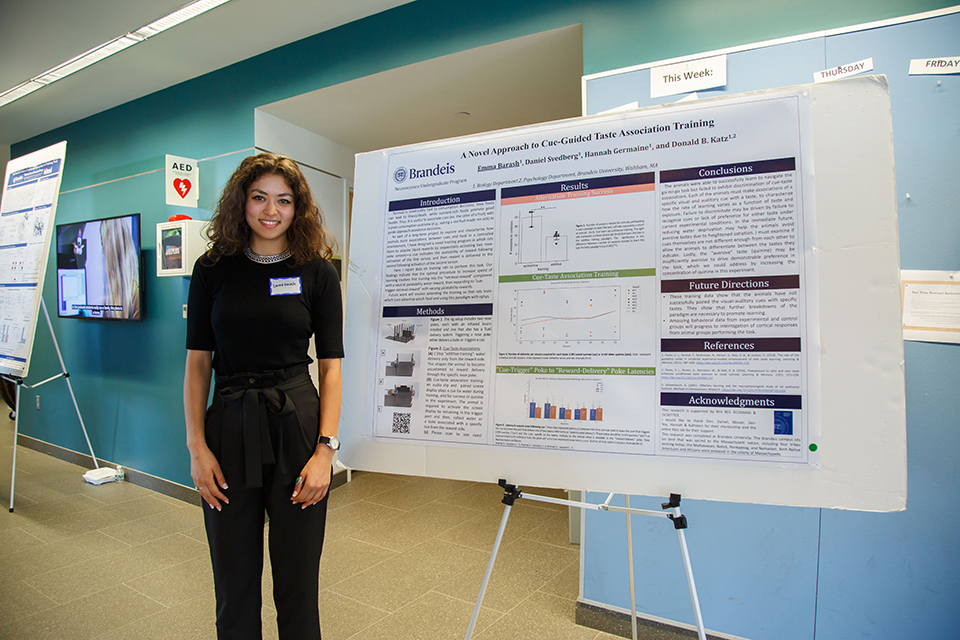Emma Barash
Katz Lab
Department of Psychology
Brandeis University
A Novel Approach to Cue-Guided Taste Association Training
 Survival is inextricably tied to consumption decisions; toxic foods can lead to illness/death, while nutrient-rich foods promote good health. Thus, it is useful to associate cues (e.g., the color of a fruit) with a post-consumption outcome (e.g., eating a red fruit made me sick) to guide approach-avoidance decisions.
Survival is inextricably tied to consumption decisions; toxic foods can lead to illness/death, while nutrient-rich foods promote good health. Thus, it is useful to associate cues (e.g., the color of a fruit) with a post-consumption outcome (e.g., eating a red fruit made me sick) to guide approach-avoidance decisions.
While cue-driven-association research is common, little research focuses on the role of cue-food associations in driving foraging/consumption. We have developed a novel experimental framework dedicated to this question. Results from "cue-food reward" association tasks in literature show that rats learn associations in ~11 - 15 days, but the tasks used are often minimally structured. We aimed to not only improve upon the learning rate but do so in an interpretation-rich multi-step response task. We designed a paradigm with a cue-trigger/retrieval-reward sequencing, with visual-auditory cues paired with unique chemosensory food properties — sucrose, a low and high concentration of sodium chloride, and quinine — ranging from most to least palatable, respectively.
Our findings indicate that the optimal procedure to increase speed of learning involves first training rats with the "retrieval-reward" component with a neutral palatability water reward, then expanding to "cue-trigger-retrieval-reward" with varying palatability rewards. The preliminary results show a fast-learning rate as well as expected behavior with rats displaying a decreased latency to response for cues indicating higher palatability rewards, and the inverse for cues indicating lower palatability rewards.
In the future, this paradigm will be expanded to include electrophysiological interrogation of neural representations of anticipation, decision and response in the gustatory cortex to understand the neural underpinnings of the differential behavior for different palatability cues.
Personal Statement
The opportunity to run this paradigm as a summer fellow has served not only as a basis for further research but has also been a formative moment in my career trajectory. Prior to my work in a laboratory, I had a misguided perception of graduate school — I was not prepared for the opportunity to be alluring. Through necessary collaborations with graduate students, I not only developed my experimental skillset, but gained unfiltered insight into their lives.
My prior perception of graduate studies was overhauled as I came to understand that graduate students select specialized and self-directed curricula, and ultimately have a great amount of control over their trajectories. Suddenly this life became alluring indeed. This insight was an unexpected and transformative revelation for me as I advance through my undergraduate career, which highlights the fact that I need further exposure to various aspects of graduate studies.
Giving Back Reflection
I have had several different opportunities to give back. Helping to lead the robotics club over the past summer allowed an excellent opportunity for me to give back for all that I received as a member of the club since my first year. This entailed supervising activities in the Automation Lab to allow new learners the thrill of building robots with cutting-edge machines and materials. In July, we attended a competition in Connecticut that galvanized us as a team, establishing our rank in the combative robotics community while inspiring the new club members with novel methods of mentorship.
Spending time with a lonely cancer patient allowed a surprise benefit in a situation that began with simply listening to and empathizing with him. We talked about common interests and the situation became unexpectedly mutually beneficial when he opened his car shop to me. He seems to truly enjoy mentoring me in car maintenance, teaching me how to take out and size spark plugs, and rebuild a transmission. He recently made the thrilling invitation for me to join him in rebuilding a Mazda Miata over the coming year.
Finally, in the neuroscience lab, I assisted in a project that involved reinstalling an experimental rig used by many of the lab members, a job that initially appeared tedious and a little daunting. It involved an initial deep cleaning of the space that housed the rig and securing it, and its computers, onto a server rack which also grounded the electrical components. As this space is in high demand for experimentation, this switch needed to be done quickly, while ensuring the delicate connections between instruments were intact. I helped my graduate student mentor with this project and still have a nice feeling about the clean, efficiently-designed space every time I begin an experiment.
